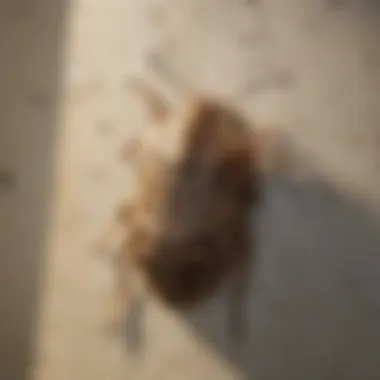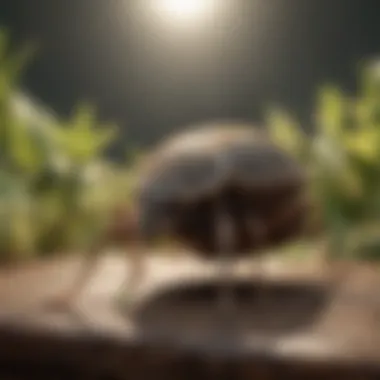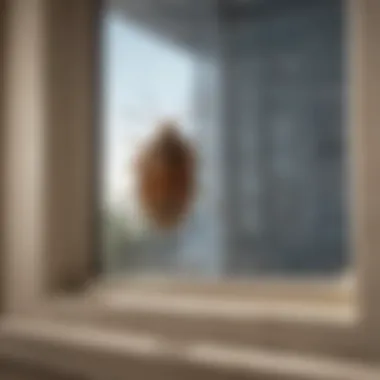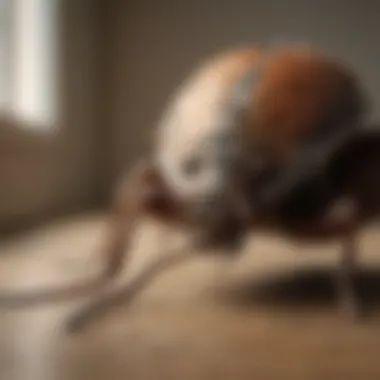Effective Strategies for Eliminating Stink Bugs


Intro
Stink bugs have gained notoriety for their unwelcome presence in homes. Their strong odor, notably when disturbed, is enough to deter many homeowners from tolerating these pests. Eliminating stink bugs from indoor spaces is not just about removal; it involves an understanding of their biology, behavior, and the methods available for effective control. This article will provide practical insights and strategies to manage stink bug infestations, helping you secure your living environment.
Understanding Pests
Definition of Pests
Pests are organisms that compete with humans for resources, causing damage to crops, property, and health. Stink bugs fall into this category due to their habit of invading homes, particularly during colder months. Their presence can lead to discomfort and can also indicate larger underlying issues in pest management within the home.
Importance of Pest Identification
Identifying stink bugs accurately is crucial for effective control. Misidentifying these pests could lead to ineffective treatment. The most common species, the brown marmorated stink bug, is easily recognized by its brown, shield-like body. Knowing which pest you are dealing with allows for more targeted and sustainable eradication strategies.
Prevention Techniques
Home and Garden Preventative Measures
To prevent stink bugs from entering your home, consider the following methods:
- Sealing Entry Points: Inspect windows, doors, and other openings. Use caulk to seal cracks and weather stripping on doors.
- Proper Landscaping: Keep shrubs and trees trimmed to promote air circulation. This makes your garden less inviting to pests.
- Reduce Attractants: Stink bugs are attracted to lights. Consider using yellow bulbs outdoors, which are less alluring to insects.
Seasonal Prevention Tips
Recognizing seasonal behaviors can aid in proactive pest management:
- Autumn: As temperatures drop, stink bugs seek shelter indoors. Inspect the outside of your home for signs of infestations.
- Spring: If stink bugs have made it inside, implement measures to ensure they do not return. Clean windows and doors regularly.
Eco-Friendly Pest Control Solutions
Overview of Sustainable Practices
Approaching pest control from an ecological viewpoint can be impactful. Using less harmful chemicals and implementing preventive measures helps create a balance with nature. Integrated pest management combines biological control, cultural practices, and physical removal, focusing on long-term prevention.
Natural Remedies and Their Effectiveness
Natural remedies can be an effective way to combat stink bugs without harsh chemicals. Some popular methods include:
- Essential Oils: Oils such as peppermint and cedar can act as deterrents when sprayed around entry points.
- Soap Solution: A mixture of dish soap and water can drown stink bugs when sprayed directly on them.
"Understanding the behavior of stink bugs can significantly enhance your home’s defense strategy against these pests."
Adopting these strategies not only addresses immediate needs but also sets a foundation for long-term pest avoidance. By integrating proactive measures and eco-friendly practices, homeowners can create a living environment that is less conducive to stink bug invasions.
Understanding Stink Bugs
Understanding stink bugs is crucial for anyone looking to manage their indoor spaces effectively. By recognizing these pests, homeowners can adopt informed strategies to control and eliminate them. Stink bugs, with their distinctive appearance and odor, can disrupt the comfort of your home. Moreover, they can infiltrate living areas during certain times of the year, particularly in fall, when they seek warmth. Knowledge about stink bugs can lead to practical solutions that may eliminate their presence.
What are Stink Bugs?
Stink bugs are a type of insect belonging to the family Pentatomidae. They are most commonly recognized by their shield-like shape and, of course, the unique odor they release when threatened. The brown marmorated stink bug is perhaps the most notorious species in the United States, known for its brownish color and the ability to invade homes. These pests primarily feed on plants, injecting saliva that can harm crops. In homes, they do not cause direct damage but pose significant nuisance due to their odor and tendency to gather in large numbers.
Life Cycle of Stink Bugs
The life cycle of stink bugs comprises several stages: egg, nymph, and adult. Eggs are typically laid on the undersides of leaves, often in clusters. After hatching, nymphs emerge and go through five instars, gradually growing into adults. This cycle takes about 30 to 60 days, depending on environmental conditions. During summer, populations can grow rapidly, leading to potential infestations as the weather cools. Understanding this cycle is vital for determining when and how to implement control measures effectively.
Common Species of Stink Bugs
Several species of stink bugs are prevalent, but a few stand out due to their impact on homes. The brown marmorated stink bug is widely known for its erratic movement and ability to invade homes. Other species include the green stink bug and the southern green stink bug. Each species displays unique traits and behaviors, which can influence how they enter homes and how easily they can be managed. By identifying the specific species involved, homeowners can tailor their approach to pest control.
"Knowledge is power. Understanding stink bugs can lead to effective prevention and control strategies."
In summary, grasping the biology and behavior of stink bugs is an essential foundation for any robust pest management strategy. Recognizing their life cycle and the common species found in residential areas equips homeowners with the tools necessary to preemptively address and eliminate these pests.


Identifying Stink Bug Infestations
Recognizing a stink bug infestation is crucial for effective management. Early detection can prevent a small problem from evolving into a significant nuisance. Stink bugs, especially the brown marmorated stink bug, may invade homes during autumn months. Understanding how to identify their presence allows homeowners to act swiftly and minimize damage.
Signs of an Infestation
Homeowners should be alert to several indicators of stink bug infestations. Some common signs include:
- Visible Stink Bugs: Spotting stink bugs, especially near windows or doors, is a clear sign of an infestation.
- Foul Odor: Distinctive odors arise when stink bugs are disturbed. This odor can permeate living spaces.
- Droppings: Small dark droppings can often be discovered in areas where stink bugs settle.
- Damage to Plants: Stink bugs can damage indoor plants, showing signs such as wilting or browning leaves.
Recognizing these signs will give homeowners a chance to take prompt action. Ignoring early signs can lead to larger infestations.
When to Seek Help
If the signs of an infestation are evident, it might be time to seek professional assistance. Consider the following factors:
- Scale of Infestation: If there are numerous stink bugs present, professional pest control services may be necessary.
- Recurring Problems: Frequent infestations suggest that there may be underlying issues needing expert intervention.
- Damage to Property: Excessive damage to indoor plants or other property can warrant professional advice and treatment.
When confronted with stubborn stink bug infestations, relying on experts can ensure thorough removal and preventive strategies moving forward.
Preventative Measures
Preventative measures are crucial in addressing stink bugs in residential areas. These strategies help minimize the chances of infestation, thereby reducing the need for more aggressive control methods later. By taking steps to deter stink bugs proactively, homeowners can create an environment that is less attractive to these pests. This not only provides comfort but also contributes to overall home maintenance and hygiene.
Sealing Entrances
One of the most effective ways to keep stink bugs out is by sealing potential entry points. During the cooler months, stink bugs seek warmth and shelter inside homes. Common locations include:
- Windows and Doors: Weather stripping or caulking around frames can prevent bugs from sneaking in.
- Ventilation Holes: Ensure any vents and chimneys are well-screened.
- Cracks and Gaps: Inspect the foundation and walls for small openings that could serve as passageways for insects.
Taking these actions not only restricts entry but also enhances energy efficiency in the home. A well-sealed house reduces heating costs, proving beneficial in multiple ways.
Environmental Controls
Adjusting the indoor and outdoor environment can significantly discourage stink bugs. Consider the following elements:
- Indoor Lighting: Stink bugs are attracted to bright lights. Using yellow-tinted bulbs can reduce their attraction.
- Moisture Control: Stink bugs prefer areas with high humidity. Use dehumidifiers in basements and ensure proper drainage around your property.
- Temperature Regulation: Keeping your home at a cooler temperature can make it less appealing to pests seeking warmth.
Implementing these changes contributes to a less hospitable environment for stink bugs and promotes a healthier living space.
Landscape Management
The area surrounding your home can impact the likelihood of stink bug infestations. Proper landscape management includes:
- Plant Selection: Avoid planting highly attractive plants such as certain fruit trees and flowers that may lure stink bugs.
- Garden Maintenance: Keep gardens tidy. Regularly remove debris and overgrown vegetation where stink bugs might hide.
- Barrier Planting: Create a buffer zone by planting less attractive species or using gravel or mulch to reduce habitat around the foundation.
Adopting these landscape strategies can help keep stink bugs at bay while also enhancing the aesthetic of your outdoor space. Through these combined efforts in sealing, adjusting environmental factors, and managing the landscape, homeowners can significantly reduce the likelihood of an infestation in their homes.
Effective Methods for Control
In the context of indoor living spaces, effective methods for controlling stink bugs are crucial. These pests can cause discomfort and disturbances in the home, besides their well-known odor when threatened. Understanding various control strategies enables homeowners to address infestations efficiently and sustainably. Immediate relief and long-term management strategies are necessary to keep indoor spaces comfortable and free from stink bugs. Residents must be aware of the control options available to them, considering both their effectiveness and environmental impact.
Vacuuming Techniques
Vacuuming is a straightforward yet effective method for controlling stink bugs inside homes. Using a vacuum allows for quick removal of visible pests, providing immediate relief from an infestation. It is important to use a vacuum with a bag, as using a bagless vacuum may result in the pungent smell of the stink bugs escaping back into the air.
To maximize effectiveness:
- Vacuum regularly: Keep a schedule for vacuuming areas where stink bugs are commonly found, such as windowsills and corners.
- Seal the vacuum bag: After collecting stink bugs, seal the vacuum bag tightly to contain any odor.
This method is particularly beneficial in the early stages of an infestation, when stink bugs are easier to manage. However, vacuuming only addresses the surface problem; sustainable solutions are needed for long-term control.
Traps and Lures


Utilizing traps and lures can be a strategic approach in controlling stink bugs. Various types of traps are available, specifically designed to attract and capture these pests. Sticky traps, for example, can be placed near suspected infestation sites.
When implementing traps, consider the following:
- Placement: Locate traps near entry points and areas where stink bugs are frequently seen. This increases the likelihood of capturing pests.
- Use of lures: Some traps come with additional lures that mimic the scents of plants to attract stink bugs more effectively.
This method can complement vacuuming or chemical treatments for a more comprehensive control approach.
Chemical Treatments
Chemical treatments come into play when infestations exceed manageable levels. There are several commercially available insecticides formulated specifically for stink bugs. When considering chemical treatments, it is crucial to adhere to safety guidelines and application instructions to ensure effectiveness and minimize risks to humans and pets.
Here are some considerations:
- Select appropriate products: Look for products containing active ingredients effective against stink bugs, such as bifenthrin or cyfluthrin.
- Follow precise instructions: Correct application is essential for achieving successful control while avoiding harm to beneficial insects or the environment.
Using chemical treatments can provide a more aggressive approach to managing severe infestations. However, care must be taken to integrate these methods into a broader pest management strategy, focusing on prevention and minimal environmental impact.
Effective control of stink bugs requires multifaceted strategies that are well-planned and executed. Integrating immediate removal with longer-term prevention techniques leads to a more enduring solution.
Natural Deterrents
The use of natural deterrents is essential for managing stink bug populations effectively. These strategies not only aim to repel stink bugs but also minimize the need for chemical solutions, which can have adverse effects on the environment and human health. Natural deterrents can provide several benefits, including safety for pets and children and a lesser impact on beneficial insects that play essential roles in our ecosystems. Adopting these methods can be part of a comprehensive pest management strategy that aligns with sustainable practices and reduced reliance on synthetic substances.
Essential Oils
Essential oils are a popular choice as a natural deterrent against stink bugs. Some oils, such as peppermint, eucalyptus, and lavender, have strong scents that insects generally dislike. These oils can be mixed with water and used in a spray bottle to treat areas where stink bugs are frequent. Here is a simple blend:
- Peppermint Oil Spray:
- 10 drops of peppermint essential oil
- 1 cup of water
- Combine in a spray bottle and shake well before applying.
Spraying door frames, window sills, and other potential entry points helps create a barrier. However, it is important to reapply every few days or after rain to maintain effectiveness.
Homemade Repellents
Homemade repellents can be another practical solution for keeping stink bugs at bay. These mixtures are not only easy to prepare but also don't contain harmful chemicals. One effective recipe involves using dish soap and water:
- Dish Soap Solution:
- 2 tablespoons of liquid dish soap
- 1 gallon of water
- Mix thoroughly and use a spray bottle for application.
This solution works by suffocating the bugs upon contact. It is wise to target areas where stink bugs have been previously seen, but caution should be taken to test any spray on a small, inconspicuous area first to avoid damage to plants or surfaces.
Beneficial Insects
Introducing beneficial insects can be an effective way to manage stink bug populations. Certain predatory insects, such as ladybugs, lacewings, and parasitic wasps, can help control stink bug numbers naturally. These insects do not harm plants and can contribute positively to garden health.
When attracting beneficial insects, consider planting a diverse range of flowers and herbs. Some good options include:
- Marigolds
- Nasturtiums
- Dill
These plants not only beautify the garden but also create habitats that encourage beneficial insects to thrive. By fostering a balanced ecosystem, homeowners can significantly reduce reliance on chemical pest controls.
When to Consider Professional Help
Considering professional help for stink bug infestations is an essential aspect of pest management that many homeowners may overlook. While DIY methods can be effective in the short term, there are instances when it is best to bring in experts. Understanding the signs that you need professional assistance can lead to quicker resolution of the problem and can save money in the long run.
Some homeowners might try to ignore the issue, believing it will resolve itself. However, failings to address an infestation can cause it to worsen. An infestation not only disrupts your living space, but it can also lead to other problems, like structural damage or health concerns. This makes recognizing the right moment to seek professional help critical for successful pest control.
Indicators for Professional Intervention
There are several indicators that may suggest it is time to call in a pest control service:
- Persistent Infestation: If stink bugs keep returning despite your efforts, this is a clear sign that professional help is needed. An ongoing presence indicates potential breeding grounds.
- Visible Egg Clusters: Finding clusters of stink bug eggs typically signals that numerous more pests are on the way. Trying to manage this alone may prove futile.
- Damage to Property: Stink bugs are known to cause damage to fruits and vegetables in gardens. If you notice damage to plants, consider professional services to protect your investments.
- Health Concerns: Allergic reactions or respiratory issues triggered by stink bugs may arise if infested spaces are not addressed. In such cases, professional intervention is advisable.
- Limited Knowledge: If you feel unsure about identifying the source or proper strategies for treatment, enlisting professionals can ensure thorough and effective pest control.


Choosing a Pest Control Service
When selecting a pest control service, it is crucial to assess various factors to ensure you are making the right choice for your situation. Here are some tips to guide you:
- Research Local Companies: Look into companies that specialize in pest control. Read customer reviews and check their credentials. Understanding their reputation can guide your decision.
- Verify Licensing and Certifications: Ensure that the company holds a valid license. Reputable companies will have the proper certifications to carry out pest control effectively and safely.
- Inquire About Methods Used: Ask potential services about their methods for dealing with stink bugs. It is important for them to have a plan that emphasizes both immediate control and long-term prevention.
- Request Estimates: Get cost estimates from several services. Comparing prices will help you find a company that fits your budget while providing quality service.
- Ask for References: A reliable company should not hesitate to provide references from previous clients. This can give you an idea of their efficacy and customer satisfaction.
Remember: The best pest control service will combine advanced techniques with a thorough understanding of the biology of pests. This dual approach ensures effective elimination and reduces the chances of future infestations.
Long-term Prevention Strategies
Long-term prevention strategies are essential in managing stink bug populations. These methods not only focus on immediate removal but also emphasize sustaining a pest-free environment over time. Homeowners can adopt certain practices to reduce the risk of future infestations while maintaining the quality of their living spaces.
Seasonal Preparation
Seasonal preparation involves specific steps homeowners can take prior to the changes in weather. This proactive approach is important because stink bugs tend to invade homes as temperatures drop. It is essential to make your home less appealing to these pests during this time.
- Inspect and Repair: Look for cracks in windows, doors, and the foundation. Repairing these openings can significantly decrease the chances of stink bugs entering.
- Seal Entry Points: Make use of weather stripping and caulking. This is critical as even small gaps may allow stink bugs to find their way inside.
- Clean Up Exterior Areas: Keep yards tidy by removing debris, such as fallen leaves, and managing the landscaping. Stink bugs are attracted to certain plants, so maintaining a clean outdoor environment can deter these pests.
- Check Screens: Ensure that screens on windows and doors are free of holes or tears. This simple step can act as a barrier, preventing stink bugs from flying in.
By taking these steps in the fall, one can dramatically reduce the likelihood of infestations during colder months.
Continuous Monitoring
Continuous monitoring is crucial for maintaining a home free from stink bugs. Once initial preventive measures are in place, it is important to regularly check for signs of infestation and actively manage any pest presence.
- Regular Inspections: Conduct routine checks around the home to identify possible entry points and signs of infestations. This could include droppings or the stink bugs themselves.
- Early Detection Systems: Utilize sticky traps or pheromone traps in strategic locations. This not only helps in trapping existing bugs but also serves as a warning sign for emerging problems.
- Maintain Cleanliness: Regularly clean areas prone to pest activity. Keeping floors clear of crumbs and ensuring surfaces are tidy can discourage the presence of stink bugs and other pests.
"An ounce of prevention is worth a pound of cure." This adage rings true with stink bugs; consistent monitoring allows for timely interventions before infestations escalate.
By incorporating seasonal preparations and ongoing monitoring into your pest management strategy, you can greatly enhance your home’s defenses against stink bugs. This focus on long-term prevention will provide both peace of mind and a healthier indoor environment.
Potential Health Concerns
Understanding potential health concerns associated with stink bugs is essential for homeowners. While these pests are not direct carriers of diseases, their presence can lead to secondary issues that impact health and well-being. Recognizing these concerns enables proactive measures against infestations, keeping living spaces healthier.
Allergic Reactions
Some individuals may experience allergic reactions due to stink bugs. The allergens can be found in their waste, shed skin, and even their body when crushed. Symptoms could range from mild to severe, including nasal congestion, sneezing, or skin irritations. In sensitive individuals, prolonged exposure can increase the severity of these reactions.
To minimize allergic reactions:
- Keep windows closed during their peak season.
- Use air filters in heating and cooling systems to trap allergens.
- Regularly clean and vacuum, ensuring the removal of any potential allergens in your home.
Taking these steps not only helps with controlling stink bugs but also promotes a healthier indoor atmosphere.
Toxicity Considerations
Stink bugs produce a chemical defense mechanism that can be toxic if ingested. Although this poses little risk for healthy adults, pets or small children may be more vulnerable. The ingestion of stink bug parts, particularly if they are ground up in food, can cause gastrointestinal discomfort.
It is vital to monitor young children or pets if stink bugs are present:
- Educate family members on not playing with or handling these bugs.
- Ensure food is properly stored, minimizing the chance of contact with stink bugs.
The End
In this article, we have provided a comprehensive overview of strategies for effectively eliminating stink bugs from indoor spaces. The significance of this topic extends beyond mere pest control; it encompasses health considerations, home comfort, and maintaining an enjoyable living environment. Stink bugs can be more than a nuisance; they risk damaging personal property and potentially introduce allergens into the home. Understanding how to manage their presence is essential for homeowners.
Summary of Key Points
Several important aspects were discussed throughout the article:
- Understanding Stink Bugs: Recognizing what stink bugs are and their life cycle is crucial for effective control.
- Identifying Infestations: Knowing the signs of an infestation allows for prompt action before the situation escalates.
- Preventative Measures: Sealing up potential entry points and managing the surrounding landscape can minimize the chances of future invasions.
- Effective Control Methods: Utilizing techniques like vacuuming, traps, and chemical treatments provides thorough options for dealing with existing pests.
- Natural Deterrents: Alternative methods such as essential oils and homemade repellents offer eco-friendly solutions.
- Professional Help: Sometimes the extent of an infestation calls for assistance from pest control services, guiding decisions on when to seek such support.
- Health Concerns: Considering the potential allergic reactions and toxicity of certain treatments is essential for household safety.
Final Recommendations
To conclude, here are essential recommendations for keeping stink bugs at bay:
- Act Quickly: If signs of infestations are observed, immediate action is more effective than waiting.
- Seal Your Home: Regularly inspect and repair cracks around windows, doors, and other openings.
- Use Traps: Consider using both commercial and homemade traps to capture stink bugs efficiently.
- Stay Informed: Keep up to date on pest control methods and techniques, as these are often evolving.
- Evaluate Your Landscape: Manage environments around your home. Trim vegetation that may attract these pests.
- Consult Professionals: If infestations persist, reach out to pest management professionals, ensuring a long-term solution tailored to your specific needs.
By applying these strategies and insights, homeowners can significantly enhance their ability to combat stink bugs, ensuring a pest-free living environment.



